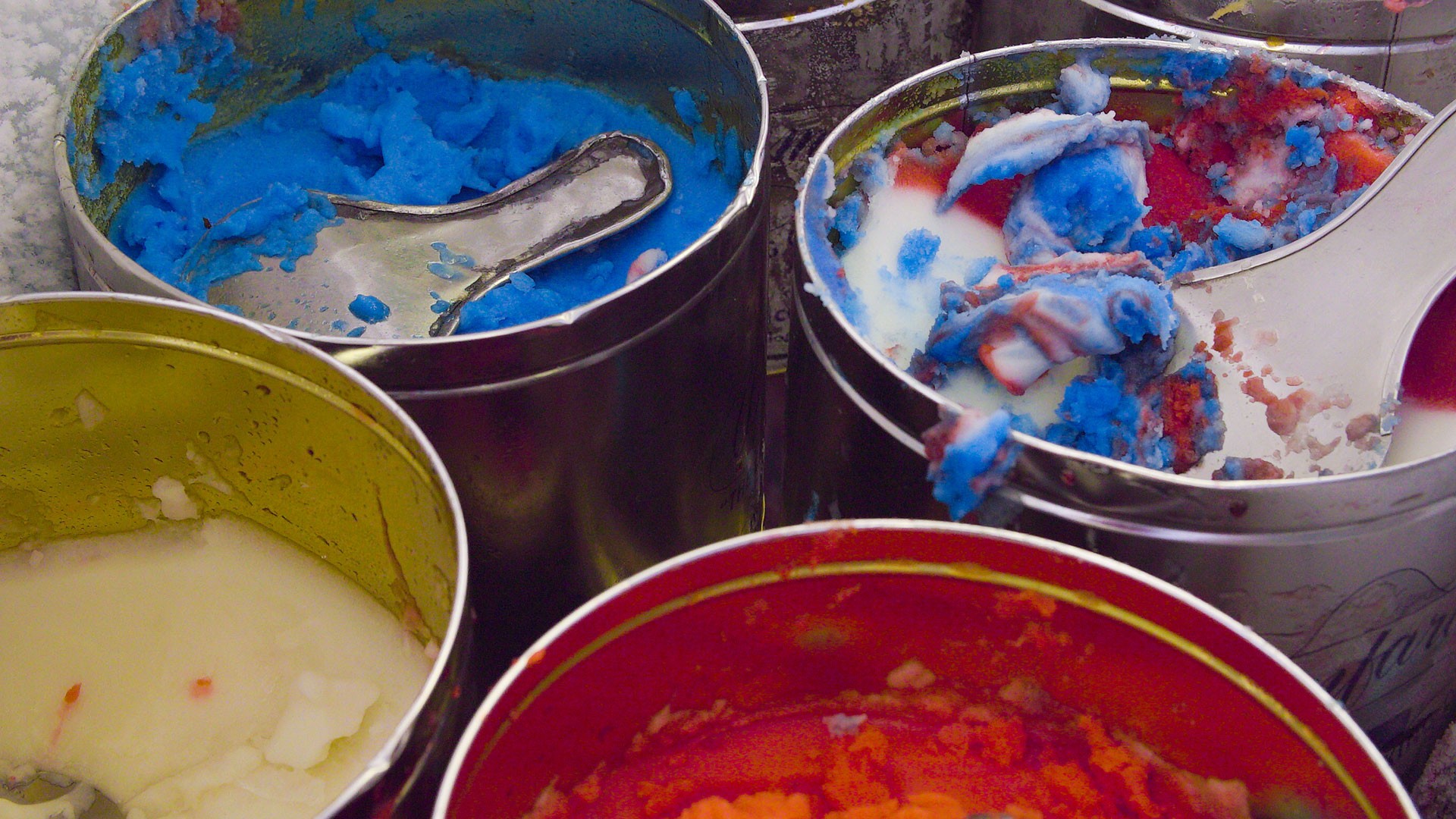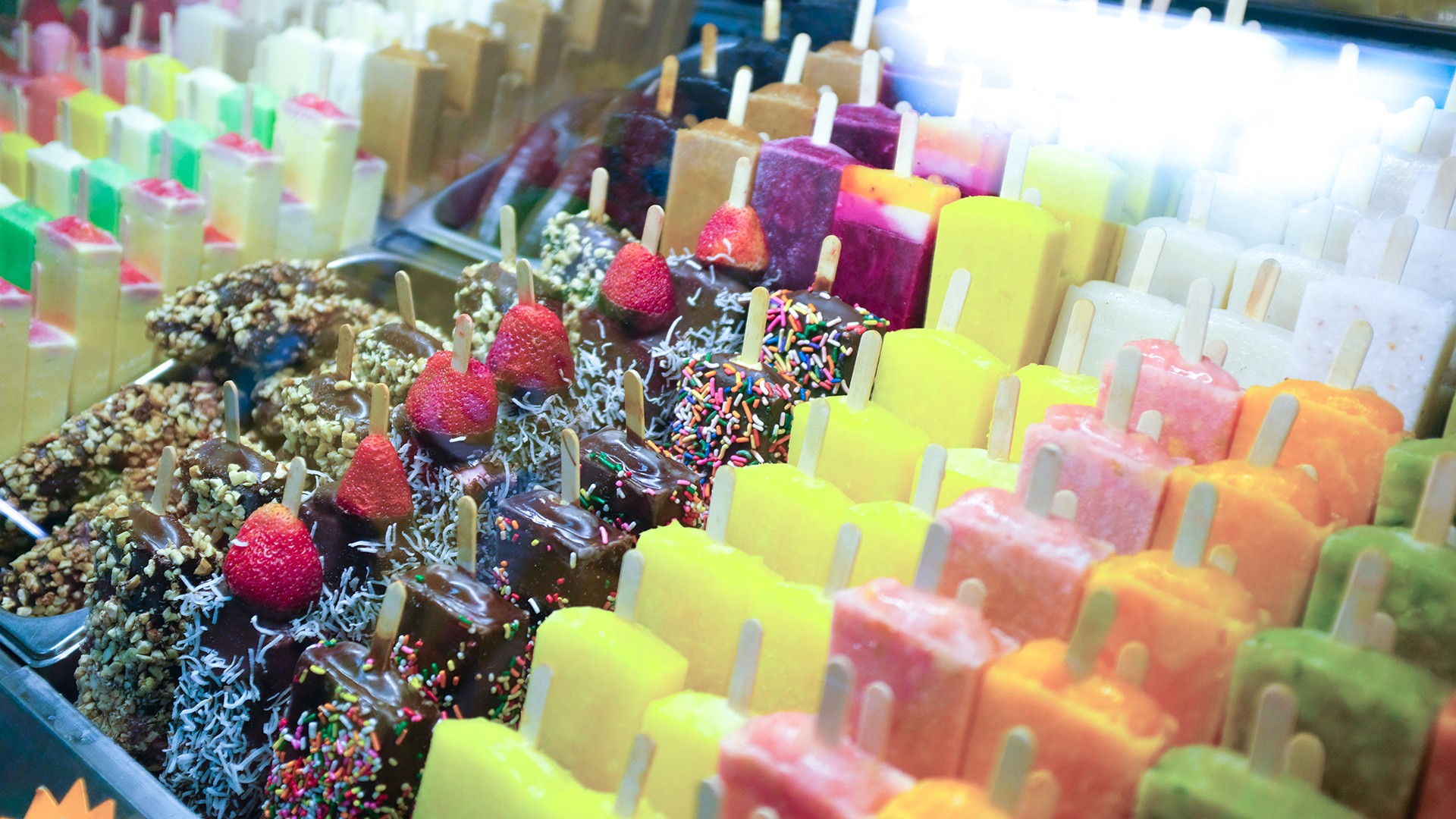Nicola Benfaremo's son Pete in his designated chair beneath his notorious "We Do Not Mix" sign. The lemon ice purist refused to allow customers to mix flavors in the same cup. Photo courtesy of flickr user gabe gross.
On tonight’s episode of THE ICE CREAM SHOW, our host Isaac Lappert explores some of the most iconic Italian frozen treat makers from across New York, among them a beloved neighborhood mainstay of Central Queens—Benfaremo’s, The Lemon Ice King of Corona.“It sounds like you guys were some of the founders of this style,” says Lappert. “You might not say it, but I’ll go ahead and say it for you—you guys created Italian ice.”Co-owner Vinny Barbaccia laughs and says, “No one else is taking credit for it, so we'll take that credit!” On the sprawling family tree of fruity churned ice treats in America, all of these beloved neighborhood staples can trace their roots back to a common ancestor—the Sicilian granita. As food writer and historian Jeffrey Steingarten wrote in an essay titled “The Mother of All Ice Cream,” the secrets of granita could be found at the top of Mount Etna, where the snow from her frozen peaks was “the primeval origins of every ice and ice cream that came after.” Using the snow they harvested there, Arab migrants in Sicily developed the dish that led to the frozen fruit ice treat we know today, with regional variations developing as the dish spread throughout the island.
On the sprawling family tree of fruity churned ice treats in America, all of these beloved neighborhood staples can trace their roots back to a common ancestor—the Sicilian granita. As food writer and historian Jeffrey Steingarten wrote in an essay titled “The Mother of All Ice Cream,” the secrets of granita could be found at the top of Mount Etna, where the snow from her frozen peaks was “the primeval origins of every ice and ice cream that came after.” Using the snow they harvested there, Arab migrants in Sicily developed the dish that led to the frozen fruit ice treat we know today, with regional variations developing as the dish spread throughout the island. Like its Italian forefather, American-style Italian ice preferences for texture, flavor, and sweetness varies city by city. In New York and New Jersey, the preference for Italian ice texture has become the creamy, semi-solid style of Benfaremo’s and Di Cosmo’s, achieved through slow, small-batch churning as it freezes. In Philadelphia and its surrounding areas, the preference has become for the end product to take on a less-firmly set, slushy texture. (This looser consistency is, most likely, where the term “water ice” comes from, the regionalism for Philadelphia’s version of granita.)Italian ice, then, in whatever form we know it—be it the authentic, small-batches of Di Cosmo’s or the packaged Luigi’s or Rosati's Italian ice cups you can find in your local freezer section—is the closest living relative we have to the origins of frozen treats as we know them. Who knew such an artifact of culinary history was right there at our fingertips all this time?For more about the legacy of Italian frozen treats in New York City, tune into tonight's episode of The Ice Cream Show at 10:30 PM on VICELAND.
Like its Italian forefather, American-style Italian ice preferences for texture, flavor, and sweetness varies city by city. In New York and New Jersey, the preference for Italian ice texture has become the creamy, semi-solid style of Benfaremo’s and Di Cosmo’s, achieved through slow, small-batch churning as it freezes. In Philadelphia and its surrounding areas, the preference has become for the end product to take on a less-firmly set, slushy texture. (This looser consistency is, most likely, where the term “water ice” comes from, the regionalism for Philadelphia’s version of granita.)Italian ice, then, in whatever form we know it—be it the authentic, small-batches of Di Cosmo’s or the packaged Luigi’s or Rosati's Italian ice cups you can find in your local freezer section—is the closest living relative we have to the origins of frozen treats as we know them. Who knew such an artifact of culinary history was right there at our fingertips all this time?For more about the legacy of Italian frozen treats in New York City, tune into tonight's episode of The Ice Cream Show at 10:30 PM on VICELAND.
Advertisement
But while the Benfaremo Italian ice slingers might be the kings of Queens (and maybe the rest of the five boroughs), they are not, in fact, the originators of Italian ice as Americans know it today. Not even close, really.That claim, as far as we can be sure through remaining records, belongs to Di Cosmo’s Italian Ice, just across the river in Elizabeth, New Jersey. While Nicola Benfaremo founded his lemon ice company out of a Corona garage in 1944, the Di Cosmo family started churning the same sort of lemon ice as far back as 1915.As in most things canon one way or another, there's fierce competition for not only being the first, but also being the best. It's a tricky distinction, though, with the ingredients being so limited—pure fruit juice, water, and sugar. In south Philadelphia, another neighborhood pocket that was once populated by almost solely Italian immigrants, long time residents pledge their loyalties to either John’s, opened in 1945, or Mancuso & Son, opened in 1939.

Advertisement
